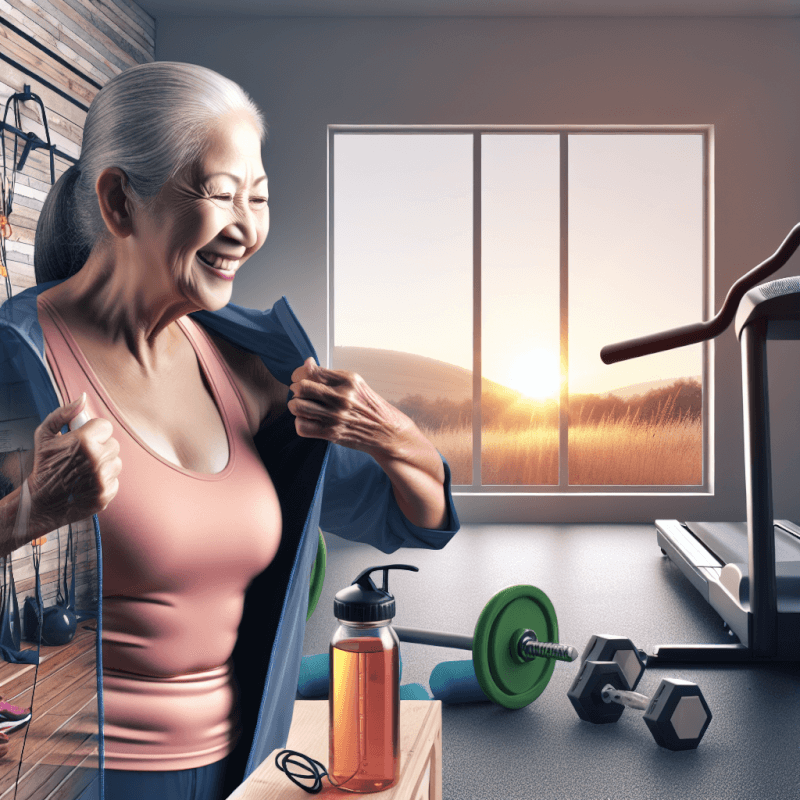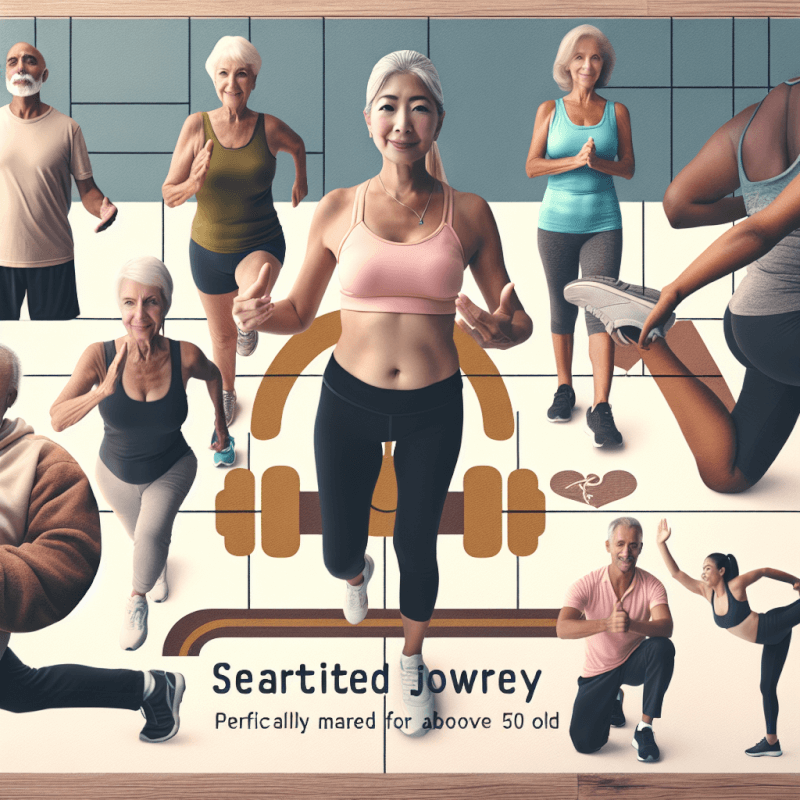Are you over 50 and wanting to get back into an exercise routine? It’s never too late to prioritize your health and well-being. In this article, you’ll discover practical tips and guidance on how to begin working out again at 50. Whether you’re a seasoned athlete or a beginner, these strategies will help you ease into a fitness routine, stay motivated, and enjoy the benefits of a physically active lifestyle. Get ready to embrace a healthier and more energized version of yourself.
Evaluate Your Current Fitness Level
Consult with a healthcare professional
Before you embark on a fitness journey, it’s crucial to consult with a healthcare professional. They can assess your overall health and provide valuable guidance based on your medical history and any pre-existing conditions you may have. This step ensures that you’re starting your fitness journey on the right foot and taking into consideration any specific needs or limitations you may have.
Assess your overall health
Take a moment to reflect on your overall health. Consider factors such as your current weight, blood pressure, cholesterol levels, and any chronic conditions you may be managing. Evaluating your health allows you to have a clear picture of where you stand and identify any areas that may need attention or improvement.
Consider any pre-existing conditions
If you have any pre-existing conditions, it’s essential to take them into account when starting a new workout routine. Certain exercises may need to be modified or avoided altogether, depending on your specific condition. By considering these factors, you can tailor your fitness plan to suit your unique needs, ensuring a safe and effective workout experience.
Take note of your fitness goals
Before you dive into a workout routine, take a moment to define your fitness goals. Whether you want to lose weight, increase flexibility, build strength, or improve cardiovascular endurance, having a clear goal in mind will help guide your exercise choices and keep you motivated along the way. Write down your goals and refer back to them often to stay focused and track your progress.
Set Realistic Goals
Focus on long-term health benefits
As you embark on your fitness journey, it’s important to focus on long-term health benefits rather than short-term results. Regular exercise can lead to improved cardiovascular health, increased energy levels, better sleep, and reduced risk of various diseases. By keeping these long-term benefits in mind, you’ll be motivated to stay consistent and make exercise a lifelong habit.
Consider your age and limitations
Starting a fitness routine at 50 may require some adjustments compared to when you were younger. It’s important to consider your age and any limitations you may have. Your body may require more time to recover, and certain exercises may need to be modified or approached with caution. Embracing exercises that are gentle on your joints and taking into account your body’s natural changes can help you create a workout plan that is both effective and safe.
Start with small, achievable goals
When getting back into fitness at 50, it’s essential to start small and set achievable goals. Rome wasn’t built in a day, and neither will your fitness level. Begin with simple exercises that you enjoy and can comfortably perform without straining yourself. Gradually increase the intensity and duration of your workouts as your body adapts. Starting with small, achievable goals sets you up for success and keeps you motivated along the way.
Track your progress
Tracking your progress is a great way to stay motivated and gauge your improvement over time. Keep a record of your workouts, noting the exercises you performed, the duration, and any modifications or adjustments made. You can also track metrics such as weight loss, cardiovascular endurance, or strength gains. Seeing how far you’ve come can be incredibly empowering and inspire you to keep pushing forward.

Choose Suitable Exercises
Emphasize cardiovascular activities
Cardiovascular exercises are an excellent way to improve your heart health, endurance, and overall fitness level. Activities such as brisk walking, swimming, cycling, or using an elliptical machine can get your heart rate up and help burn calories. Aim for at least 150 minutes of moderate-intensity cardiovascular exercise each week, or 75 minutes of vigorous-intensity exercise if your health allows.
Incorporate strength training
Strength training is crucial for maintaining muscle mass, bone density, and overall functional fitness. As we age, our muscle mass naturally declines, so it’s important to incorporate resistance exercises into our routine. This can be done using weights, resistance bands, or even bodyweight exercises like squats and push-ups. Aim to include strength training exercises at least two days a week, targeting all major muscle groups.
Include flexibility and balance exercises
Flexibility and balance exercises are often overlooked but are crucial for maintaining mobility and preventing injuries. Activities like yoga, tai chi, or stretching exercises can help improve flexibility, joint range of motion, and balance. Regular practice of these exercises can enhance your overall functional fitness, making daily tasks easier and reducing the risk of falls.
Try low-impact options
As we age, our joints may become more susceptible to injury or discomfort. Choosing low-impact exercises can help minimize stress on the joints while still providing an effective workout. Activities like swimming, biking, using an elliptical machine, or practicing low-impact aerobics can be great options to protect your joints while staying active and improving your fitness level.
Warm-Up and Cool Down
Perform a dynamic warm-up
Before starting any exercise session, it’s important to warm up your muscles to reduce the risk of injury. A dynamic warm-up, which involves moving your joints through a full range of motion, can increase blood flow, loosen up your muscles, and prepare your body for the upcoming workout. Include exercises like arm circles, leg swings, and trunk twists to get your body warmed up and ready to go.
Cool down with static stretches
After completing your workout, take the time to cool down and stretch your muscles. Static stretches involve holding a position for 15-30 seconds, allowing your muscles to relax and recover. Stretching can improve flexibility, reduce muscle stiffness, and help prevent muscle imbalances or post-workout soreness. Focus on stretching all major muscle groups, such as your calves, thighs, chest, shoulders, and back.
Gradually increase and decrease intensity
When starting your workout, ease into it gradually by gradually increasing the intensity of your exercises. This allows your body to warm up and prevents sudden strain or injury. Similarly, when finishing your workout, gradually decrease the intensity to allow your heart rate to return to normal and your body to cool down gradually. Abruptly stopping intense activity can lead to dizziness or muscle discomfort.
Include warm-up and cool-down into your routine
Incorporating warm-up and cool-down into your exercise routine should be a non-negotiable habit. Treat them as valuable parts of your workout, just like the main exercises. By consistently warming up and cooling down, you’ll reduce the risk of injury, improve your overall performance, and aid in muscle recovery. So always remember to allocate time for these essential components of your fitness routine.

Start Slowly
Begin with light intensity workouts
As you start your fitness journey at 50, it’s crucial to begin with light intensity workouts. This allows your body to adapt gradually and reduces the risk of overexertion or injury. Start with exercises that you enjoy and that are within your comfort zone. As you build strength and endurance, you can gradually increase the intensity of your workouts.
Gradually increase duration and intensity
As your body adapts to the initial light intensity workouts, gradually increase both the duration and intensity of your exercises. Slowly add more minutes to your cardio sessions or increase the weight or repetitions in your strength training exercises. This progressive approach ensures that your body continues to be challenged and makes consistent progress while still being mindful of your individual limitations.
Take rest days to allow for recovery
Rest days are just as important as the workout days. They allow your body time to recover, repair muscles, and restore energy levels. As you get older, your body may require more recovery time, so be sure to listen to your body and incorporate rest days into your routine. This doesn’t mean you have to be completely sedentary on rest days; opting for low-intensity activities like stretching or gentle walks can still be beneficial.
Listen to your body
Listening to your body is key, no matter your age or fitness level. Pay attention to any pain, discomfort, or unusual symptoms during or after exercise. If something doesn’t feel right, don’t push through it. Modify or adjust the exercise as needed or consult with a healthcare professional or a fitness expert for guidance. It’s important to prioritize your safety and well-being above all else.
Create a Routine
Schedule regular workout sessions
To make exercise a consistent part of your life, it’s crucial to schedule regular workout sessions. Treat them as non-negotiable appointments with yourself. Block off specific times each week for your workouts and stick to them as much as possible. By creating a routine and adhering to it, you’ll establish a healthy exercise habit that becomes second nature.
Mix up your exercises
Variety is the spice of life, and it applies to your workout routine as well. Mixing up your exercises not only keeps things interesting, but it also challenges different muscle groups, prevents plateaus, and reduces the risk of overuse injuries. Try incorporating different types of exercises, such as cardio, strength training, and flexibility workouts. Consider trying new classes, outdoor activities, or workout apps to keep your fitness routine exciting and engaging.
Find activities you enjoy
Exercise doesn’t have to be a chore; it can and should be enjoyable. Find activities that you genuinely enjoy doing. Whether it’s dancing, hiking, swimming, or practicing yoga, engaging in activities you love increases the likelihood of sticking to your fitness routine. When you genuinely enjoy what you’re doing, it won’t feel like a burden, and you’ll be more likely to stay consistent and motivated.
Make it a habit
Consistency is key when it comes to fitness. Aim to make exercise a daily habit, just like brushing your teeth or eating breakfast. Start by dedicating a specific time each day to physical activity, whether it’s in the morning, during lunch breaks, or in the evening. Over time, your fitness routine will become ingrained in your daily life, and it will feel odd to skip a workout. It’s all about prioritizing your health and making your well-being a top priority.

Seek Professional Guidance
Work with a personal trainer
If you’re unsure about how to structure your workouts or need guidance on proper form and technique, consider working with a personal trainer. A certified professional can customize a workout plan based on your goals, abilities, and any limitations you may have. They can also provide motivation, accountability, and the expertise needed to ensure you’re exercising safely and effectively.
Consider group classes or fitness programs
Group classes or fitness programs can be a great way to exercise in a supportive and motivating environment. Look for classes specifically designed for individuals over 50, as they often focus on flexibility, balance, and joint-friendly exercises. Not only will you benefit from expert instruction, but you’ll also have the opportunity to socialize and connect with like-minded individuals who are on a similar fitness journey.
Join a senior-focused exercise program
Senior-focused exercise programs are designed specifically for older adults and take into account age-related considerations and common health conditions. These programs often offer a range of activities, from gentle yoga to water aerobics and everything in between. By joining a senior-focused exercise program, you can ensure that your workouts are tailored to your needs, providing a safe and supportive environment to stay active at your own pace.
Get feedback and guidance from experts
When it comes to your health and fitness, don’t hesitate to seek feedback and guidance from experts. Whether it’s a physical therapist, nutritionist, or sports medicine specialist, professionals in these fields can provide valuable insights and recommendations to optimize your fitness journey. They may suggest specific exercises, dietary modifications, or additional treatments that can support your goals and overall well-being.
Focus on Nutrition
Eat a balanced diet
Exercise alone isn’t enough to achieve optimal health and fitness. Proper nutrition plays a vital role in supporting your fitness efforts. Focus on eating a balanced diet that includes a variety of fruits, vegetables, whole grains, lean proteins, and healthy fats. Aim to limit processed foods, sugary snacks, and excess salt in your diet. Nourishing your body with quality nutrients will provide the energy and nutrients necessary for your workouts and aid in recovery.
Include protein for muscle recovery
Protein is essential for muscle recovery and growth. Incorporate lean protein sources such as chicken, fish, tofu, legumes, and Greek yogurt into your meals and snacks. Protein helps repair and build muscle tissue, especially after strength training exercises. Consuming an adequate amount of protein along with regular exercise will support muscle development and aid in overall fitness progress.
Stay hydrated
Staying hydrated is crucial for overall health and exercise performance. Make sure to drink plenty of water throughout the day, especially before, during, and after your workouts. Adequate hydration helps maintain proper body temperature, lubricates joints, and transports nutrients to your muscles. Pay attention to your body’s thirst cues and aim to drink enough water to stay adequately hydrated.
Consider dietary supplements if necessary
In some cases, dietary supplements may be beneficial to support your fitness goals. However, it’s important to consult with a healthcare professional or registered dietitian before starting any supplements. They can assess your specific needs and recommend supplements that are safe and appropriate for you. Remember, supplements should complement a healthy diet, not replace it.

Listen to Your Body
Pay attention to pain or discomfort
When exercising, it’s crucial to pay attention to any pain or discomfort that you may experience. Muscle soreness is normal, especially after beginning a new fitness routine or increasing the intensity of your workouts. However, sharp or persistent pain should not be ignored. If you experience any pain that is not consistent with muscle soreness, it’s important to address it promptly and seek appropriate medical attention if needed.
Modify or adjust exercises as needed
There’s no one-size-fits-all approach to exercise, especially as we age. It’s essential to listen to your body and modify or adjust exercises as needed. If a particular exercise causes pain or discomfort, try alternative movements that target the same muscle groups. Don’t be afraid to ask for help or seek guidance from a fitness professional who can recommend suitable modifications for your specific needs.
Know when to take breaks
Rest and recovery are essential components of any fitness routine, regardless of age. Overtraining can lead to fatigue, decreased performance, and increased risk of injury. Pay attention to your body’s signals and know when to take breaks. If you’re feeling excessively tired, if your muscles are constantly sore, or if you’re experiencing signs of burnout, it’s time to give yourself a well-deserved break. Listen to your body and prioritize rest when needed.
Don’t push yourself too hard
While it’s important to challenge yourself and strive for progress, it’s equally important not to push yourself too hard, especially when starting a new fitness routine at 50. Be realistic about your current fitness level and make gradual progressions. Pushing yourself too hard too soon can lead to injuries or burnout, potentially derailing your fitness journey. Remember, fitness is a marathon, not a sprint, so pace yourself accordingly.
Stay Consistent and Motivated
Set reminders or use fitness apps
In today’s busy world, it’s easy to get caught up in daily responsibilities and push exercise to the bottom of the priority list. To stay consistent and motivated, set reminders on your calendar or use fitness apps that send push notifications or track your workouts. These tools can help keep exercise at the forefront of your mind and ensure that you’re dedicating time to your fitness goals.
Find an accountability buddy
Having an accountability buddy can significantly boost your motivation and adherence to your fitness routine. Find a friend, family member, or colleague who shares similar fitness goals and commit to working out together regularly. Having someone to share your journey with, celebrate milestones, and hold you accountable can make the entire process more enjoyable and rewarding.
Track your progress and celebrate milestones
Tracking your progress is a powerful way to stay motivated and recognize your achievements. Use a fitness journal, a mobile app, or even a simple spreadsheet to record your workouts and track your progress. Celebrate milestones along the way, whether it’s completing a certain number of workouts, reaching a specific weight or fitness goal, or simply sticking to your routine consistently. Acknowledging your progress will keep you motivated and excited to continue.
Stay positive and enjoy the process
Above all, focus on staying positive and enjoying the process. Remember that fitness is a lifelong journey, and every step, no matter how small, is a step in the right direction. Embrace the joy of being active, challenge yourself, and don’t be too hard on yourself when faced with setbacks or obstacles. Maintaining a positive mindset and finding pleasure in your fitness routine will help you stay consistent and make your workouts something to look forward to.



